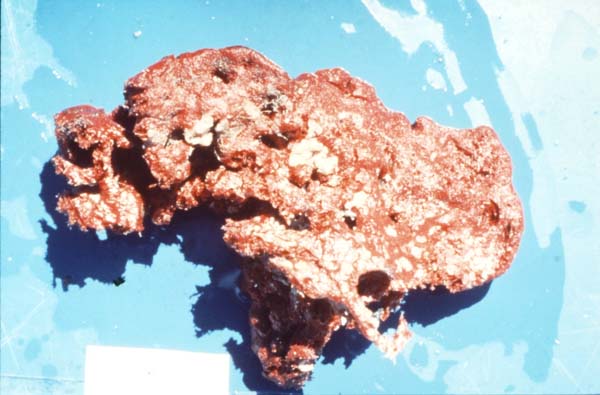Morphological description (show/hide)
| (QM G300014) Groups of solitary, conical or cylindrical digits, up to 60mm high, 20mm basal diameter, 9mm diameter at apex, erect on substrate, with common basal attachment on or below substrate. Digits evenly cylindrical or slightly flattened. (NTM Z3871) Bulbous encrusting in sand sediment. | | Red-orange alive (Munsell 2.5R 5/10), orange- | | Oscules prominent in live material, evenly dispersed over sides and apex of digits, about 1-2mm diameter, slightly raised above surface 2-3mm high. | | Slightly conulose, granular surface, with visible dermal membrane. | | Skeleton composed of 2 distinct structures. Main skeleton a meandering reticulation of thick, well-formed spongin fibres fully cored by multispicular tracts of smooth oxeas, 50-85ï¾µm diameter, eventually culminating in erect plumose brushes of smooth oxeas at surface. Fibre meshes relatively cavernous, 140-220ï¾µm diameter, oval to eliptical, with light collagen visible around eliptical choanocyte chambers, 60-130 long, 30-50ï¾µm wide. Secondary skeleton renieroid, more-or-less regularly reticulate, overlaying primary reticulate fibre skeleton, each element of renieroid reticulation composed of 2 or more acanthoxeas joined at nodes by collagenous spongin. Secondary skeleton ceases about 200-250ï¾µm from surface crust. Most megascleres confined to one or the other skeletal structures, few spicules scattered within mesohyl. | | Thick crust of acanthoxeas lie tangential to surface, 100-350ï¾µm thick, with plumose brushes of smooth oxeas, arising from major choanosomal spicule tracts, standing perpendicular to surface crust and protruding slightly through it, but more-or-less obscured by tangential surface crust. Moderately light granular collagen permeates surface crust. | | Choanosomal fibres cored by smooth oxeas, long, thin, slightly curved, usually symmetrical, occasionally modified to styloids, usually with hastate points (256-(244.0)-331 x 1.8-(2.9)-4.0). Ectosomal and choanosomal acanthoxeas identical in morphology and size, long, thin, symmetrically curved, with small granular spines evenly dispersed over spicule and with sharp fusiform points (148-(152.4)-157 x 1.5-(1.8)-3.0). | | Isochelae arcuate, moderately large, uncommon, thinner, poorly silicified examples also seen, with rudimentary development of alae, presumably juvenile forms of large chelae (18-(20.2)-22). |
|

